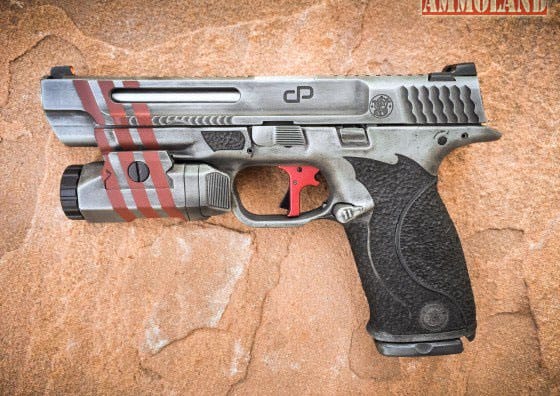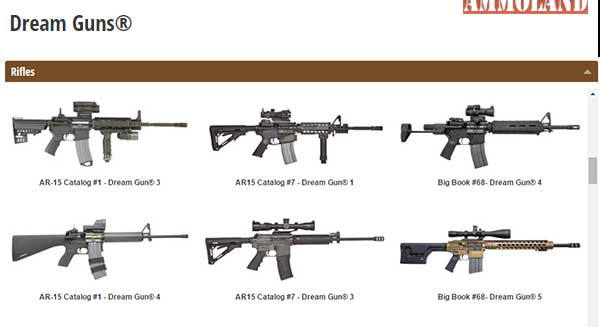This article first appeared on GunPatent.com , Article by Bennet K. Langlotz, Patent and Trademark Attorney


Dallas, TX – (Ammoland) – On December 23rd 2015, I ducked away from the family fun and checked my Facebook page only to find some firearms industry news with trademarks at the heart of the issue. Y’all know how I love trademarks, and will tell you that they might just be the most valuable asset of your company. But there are limits. And I believe those limits were embarrassingly exceeded in a PR debacle that generated a rapid-fire social media response.
It turns out that the owners of the most powerful trademark in the firearms industry*, the thousand-pound gorilla, decided to throw some weight around. You see, they learned to their horror that some guys had bought a Smith & Wesson M&P pistol, and decided to improve it. To soup it up. To modify it. Just as countless enthusiasts have done through the ages.
*(Yes, I believe that “Smith & Wesson” is probably the most valuable trademark in our industry)
Like when I first started out as a gun enthusiast late enough in life to be economically dangerous, I couldn’t buy a new gun without soon taking it apart, chasing a few springs, rubbing some surfaces with a stone, cleaning out all than nasty gunk, and putting in some fresh nasty gunk. Sometimes, I’d buy new replacement parts, or send it off to someone like Bruce Gray for improvement (He and I recently chatted about how we were doing business with each other before either of us was known in the industry). On special occasions, I might even have something machined, plated, or coated. In one instance I disliked a trigger so much I actually invented a replacement part that I patented and which still earns me a modest side income from sales on the world’s ugliest website.
Here was the plan that generated all the heat:
Take the M&P, and turn it into a “Dream Gun” with all the goodies that the geeks demand. The most dramatic aspect is machining the slide to lighten it up. The rest included trigger parts, stippling of the plastic frame, and coating. It was part of the Brownells DREAM GUN® project – yes, I verified that they have registered the trademark. They’ve been doing this since early 2013, and it included buying off-the shelf guns, modifying them, and then promoting them to their customers as a way to promote the upgrade parts that Brownells has in their catalog. Companies like Glock and my client Ed Brown have been honored this way.
Finally, Smith & Wesson earned the honor that would place their product in the prominent glass case at the Brownells SHOT Show both.
What I always ask the Internet Legal Experts
On Christmas Eve eve, Facebook started going crazy with the news that Smith & Wesson sent a lawyer letter to the companies involved, demanding that they drop the program, promise not to display or sell any modified S&W pistols, and send them all that they had. Of course since it was the internet, there were lots of opinions but not many facts. I asked anyone to post the letter, so we could see what was actually being demanded. I didn’t quite believe it could be as simple as “Our trademark means you can’t put new parts into YOUR gun, and sell it.” I always ask for the actual legal material before spouting off on the internet. I also do this when anyone is complaining about a terrible patent, or bragging about a good one. They’re public, so please just let me know the patent number so I can look for myself.
Anyway, within a few hours the full letter was up on the internet. I was amazed.
Everything those crazy hotheads were saying was true. Smith & Wesson was demanding that modified guns they originally made not be sold if they still bore the Smith & Wesson trademarks. The crazies were right: it was like Jeep telling you that you had to strip the badges if you added a winch, or Ford telling you that they’d sue you if you sold your truck after dropping in a bigger engine!
The letter was a well-written 5-pager from Smith & Wesson’s law firm, signed by a lawyer I’ve worked with on the other side of the table on behalf of my own clients. It began by recounting S&W’s history, and described how the M&P pistols were in 2005 recognized as “bold new entrants into the polymer frame pistol category.” (One snarky commenter noted how they weren’t exactly the first polymer-frame striker fired pistol back then). The letter continued, listing all the trademarks that are on the pistol in question, and how these are all secured registered with the U.S. Patent and Trademark Office.
The letter transitioned to the “it has come to the attention…” paragraph in which it noted the “Dream Gun” was produced by “obtaining” (for some reason, they didn’t write “buying from our distribution network”) a M&P pistol, and “inter alia…” (which means “among other things” – why can’t these people speak English?!) “…changing the grip texture and shape, machining the slide, adding numerous accessories and replacement parts, while retaining the S&W® logo on the product.”
At this point, I know what comes next in a standard “nastygram” letter: the legal justification – and I was dying to know how they could justify this with a straight face. They wrote:
“A company or individual may not purchase original, authentic products, make modifications to the products essential elements, and then market the products under the original names and bearing the original trademarks.”
Wow. Chew on that for a minute.
To their credit, Smith’s lawyers cited proper legal authority for this. It turns out that there is a line of appellate cases from the luxury watch world. Rolex sells a watch for $5000 that costs (say) $500 because it has the Rolex brand. If they make it out of gold, they sell it for $20,000 (round numbers). If they encrust it with diamonds, they sell it for $100,000. The rarity and exclusivity of those “bling” watches command the high price in circles where a gold Rolex is hum-drum, or for hedge-fund hubbies needing a worthy apology gift after returning from a jet-set bachelor party weekend at the island of one of Bill Clinton’s pals.
So some entrepreneurs were buying $20,000 Rolexes, adding $1000 in cheap diamonds on the bezel rings, and selling them for $30,000. A tidy profit, and the cuckolded hedge-fund brides were none-the-wiser that their unfaithful husbands saved $70,000.
So even though those decisions stretch the limits of trademark law, I can see how a judge could rule in favor or Rolex because their billion-dollar trademark would truly be harmed if the highest-profit sales were lost.
I haven’t spent time with that line of cases, but we’ll assume that they were well-reasoned. Still, taking those extreme cases from the luxury watch industry to say that you can’t sell a gun that’s been customized still seems ridiculous to me. Guns are mechanical products that can come off an assembly line for a good price for an excellent functional product, or one may pay much more for a custom gun with hand-fitted and hand-selected special upgraded components. Modified guns are usually considered upgraded, proudly advertised as such, and sold at a premium. Modified luxury watches are not desirable. One most wants a new, unmodified watch. Ebay sales will advertise Used Rolexes as having “original factory diamonds” or may confess “aftermarket bracelet.” I haven’t done the analysis, but there’s good reason for the gut feel that guns and watches are different. Guns are much more like cars, with a long history of customizing. Mercedes wouldn’t demand that an AMG version remove the Mercedes badges (I believe that bought AMG instead).
Smith & Wesson’s letter continued that customer’s would be misled into thinking that these modified Dream Guns were directly from S&W, and would be covered by the factory warranty. They also worried in the letter that later sale of such a gun as “used” would deceive that buyer.
So the letter concluded with the “demand”:
- Don’t display or promote at SHOT or anywhere else.
- Don’t sell any modified firearm bearing any S&W trademark.
- Turn over to S&W all modified firearms bearing a S&W trademark.
The Social Media Firestorm
Within hours, the S&W Facebook page was covered with hostile comments, some recalling past betrayals by past owners. Some folks wanted to believe that Smith’s management couldn’t possibly be so foolish, and argued that this must have been the act of a rogue lawyer (in 25 years of practice I’ve never seen a lawyer write a letter threatening a lawsuit without the permission of management).
The accused infringers were facing a long weekend of holiday heartburn until they could counsult legal counsel. But within hours, and by the next day, everything had changed.
James Debney, President and CEO of Smith & Wesson, said, “I would like to clarify that we fully support the Brownells Dream Guns® Project and we appreciate that it showcases the many ways in which our customers – loyal fans of our M&P brand – can choose to customize their M&P firearms. Our decision to contact the companies that worked on the project was intended to protect the trademarks that support the M&P brand. When a product bears the Smith & Wesson and M&P trademarks and is purchased new with our lifetime service policy, we want to be sure that the consumer knows it has passed our demanding quality standards. In our efforts to protect that promise and to preserve the brand that we and our customers cherish, we did not fully understand the intent of the Dream Guns® Project and we overlooked the opportunity to convey our enthusiasm for the creativity and innovation that Brownells and all of the companies involved have demonstrated. We look forward to seeing the firearm on display at the upcoming SHOT Show in January and at the NRA in May.”
I was glad to see the issue resolved, because these are all good companies who have better things to do than spend the next year in a legal dispute. But there’s one thing missing from this letter from Mr. Debney: any acknowledgment that anyone may modify and sell guns that bear the Smith and Wesson trademarks. Nothing in this resolution retracts the amazingly aggressive and legally absurd claim made in the original letter.
Hopefully, they have no intention to proceed on that theory ever again, and it’s absence in the resolution is a quiet way of saving face. (And I know I will hear from a few pals at SHOT that I shouldn’t be stirring this pot!)
I can accept that they didn’t realize that the Dream Guns® program wasn’t about selling whole modified guns, it’s about promoting the parts and companies that do the modification (It took me 2 minutes on the Internet to learn that from the Brownells website). But how can S&W have “enthusiasm” for a program that promotes modification of Smith and Wesson guns while also contending that customers would be confused into thinking that a modified gun will “present significant safety and quality concerns” as argued in the original letter?

Help me out, Smith & Wesson
I call on Smith & Wesson to make a clear statement on their position on the practices of hobbyists, gunsmiths and specialty companies that buy their guns, make changes that increase their value in the eyes of the marketplace, and resell them with the original Smith & Wesson trademarks intact (never mind the regulatory problems with grinding off a BATFE-mandated Smith & Wesson manufacturer “roll stamp” on the frame). Was the first letter wrong, or are they still going to sue companies that sell tricked out M&Ps? If they hold a hard line, they risk losing the enthusiast market.
My marketing suggestion is for the in-house custom shop at Smith & Wesson to turbocharge their efforts, and work with the creative outside companies that are in better touch with the cutting edge enthusiasts. Maybe even acquire a few of these companies.
Knife makers offer their 3% royalty to knife designers who can provide them with something fresh and new, so why not reward those who come up with the most popular configurations?
My legal solution to this kind of mess is still pro-trademark, and it’s pro-competition, pro-consumer. Simply make it clear as a bell to any buyer what they are getting. A simple disclaimer like:
Our Frankenpistol™ firearms are based on original Smith & Wesson® firearms that are purchased new, and modified like crazy. We throw out a bunch of their parts, and add a bunch of other parts that we hope you think make the gun better in many ways. Smith & Wesson may disagree about that, and does not warrant our products or promise to service them. They don’t endorse what we do and probably think we’re a little crazy or they’d probably be doing it already. One thing we don’t modify is the S&W trademark they put on their guns. We think it’s nice to give credit to the “donor” but we want to make sure that our custom pistols are strictly a Frankenpistol™ product, with no association with Smith and Wesson other than that it’s an outstanding company like many others that contribute important components to our finished custom firearms.
The short, less cheeky version: “Our products are based on the pistols of other manufacturers, and while they retain the original trademarks, they are not endorsed or warranted by those companies.”
The lesson here is to think very carefully before you threaten to sue your customers. Pick up the phone, and see if there might be a beneficial business relationship that can be formed. After all, those who think it’s worth the headache to build a company around buying and improving your company’s products are probably your very, very best customers. So try not to piss them off.
About:
Ben Langlotz is the nation’s leading firearms patent and trademark attorney, the gun patent lawyer. He is trusted by more firearms industry companies than any other lawyer or law firm in the nation, and is consistently ranked at the top of all attorneys in securing gun patents and gun trademarks.
The bookshelf of nearly every firearms industry CEO has a copy of Ben’s essential book The Bulletproof Firearms Business – The Legal Secrets to Success Under Fire, which year after year is the best-selling book on intellectual property law for firearms business owners. Firearms inventors and start-ups find the book essential to understanding how to protect their ideas without wasting money on legal fees.
Visit Gunpatent.com

I will modify my pistol anyway I choose. I bought it,it’s mine and I will do with it as I please.
Ill Advised Actions such as this by S&W are signs of the ‘COLT DEATH SPIRAL’ syndrome taking hold at S&W.
Ben, with the greatest respect, is there anyone in the whole wide world would would be paying several thousand dollars for a handgun without realizing that it began as a humble (sorry S&W) mass produced gun that probably cost 25% or less of the cost of the custom item. Speaking of reputation, S&W must still be smarting from the Texas DPS withdrawing their pistol from service midway through training of the very first rookie class issued Smiths. Though DPS has been unusually tight lipped about the debacle, word is that the pistols were unreliable. Police departments that do have the… Read more »
S&W can’t escape the lingering after-taste problem. It may last a week, a month, or a year but there is now a segment of buyers who are looking elsewhere. They may eventually buy a S&W product but others will get a harder look than they would have otherwise. Some of those looks will turn into sales.
Whoops.